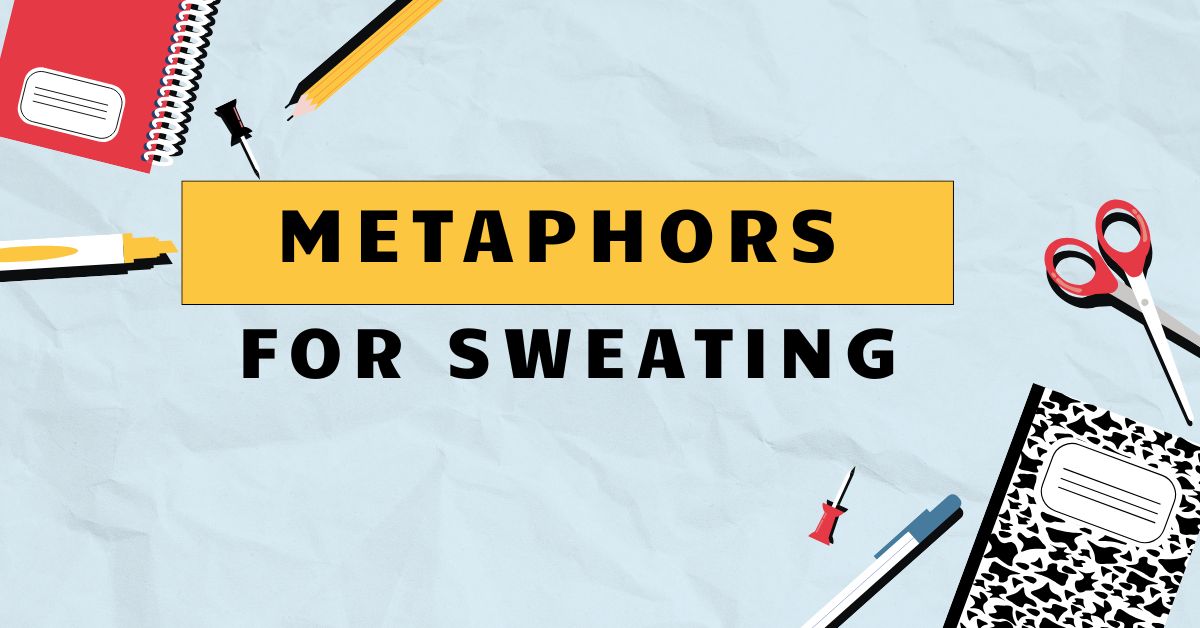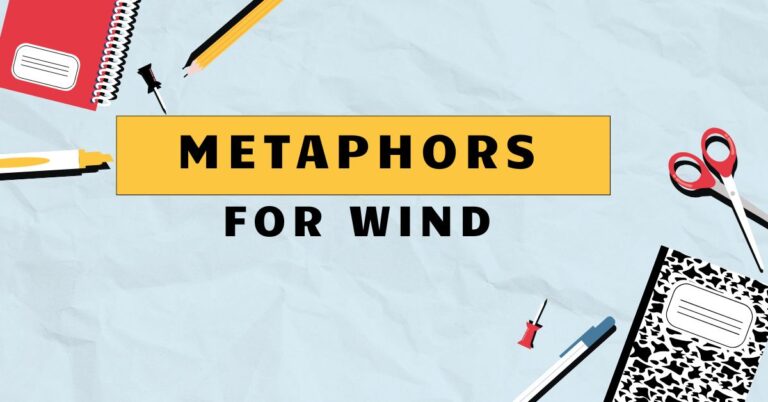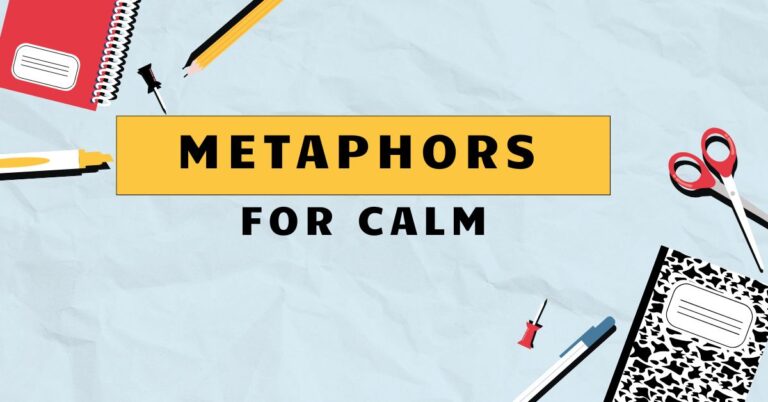39+ Metaphors for Sweating: Expressive Language in English
Sweating, a natural bodily function, can be described in various vivid and imaginative ways using metaphors. Understanding these metaphors enriches our comprehension of figurative language and enhances our ability to communicate more expressively.
This article explores the diverse metaphors employed to describe sweating, categorizing them by their underlying imagery and providing numerous examples. Whether you’re an English language learner, a writer seeking to add flair to your prose, or simply curious about the nuances of language, this guide will provide a comprehensive overview of metaphors related to sweating.
By delving into the structural and contextual aspects of these metaphors, we will uncover the nuances of their usage and learn how to avoid common pitfalls. This exploration will not only expand your vocabulary but also sharpen your understanding of how metaphors function within the broader framework of English grammar and rhetoric.
We will cover everything from basic definitions to advanced applications, ensuring a thorough grasp of the subject matter.
Table of Contents
- Introduction
- Definition of Metaphor and Sweating
- Structural Breakdown of Sweating Metaphors
- Types and Categories of Sweating Metaphors
- Examples of Sweating Metaphors
- Usage Rules for Sweating Metaphors
- Common Mistakes with Sweating Metaphors
- Practice Exercises
- Advanced Topics in Sweating Metaphors
- Frequently Asked Questions
- Conclusion
Definition of Metaphor and Sweating
Ametaphoris a figure of speech that directly compares two unrelated things, asserting that one thingisanother, to highlight a shared quality or characteristic. Unlike similes, which use words like “like” or “as” to make a comparison, metaphors imply the comparison directly.
This creates a more vivid and impactful image in the reader’s mind. Metaphors are crucial in adding depth and color to language, enabling writers and speakers to convey complex ideas and emotions in a concise and engaging manner.
Sweating, or perspiration, is a natural physiological process by which the body regulates its temperature. It involves the secretion of fluids through sweat glands in the skin.
While the literal definition is straightforward, the experience of sweating can evoke a range of sensations and associations, making it a fertile ground for metaphorical expression. The act of sweating is often linked to physical exertion, heat, stress, anxiety, or even fear, providing a rich tapestry of emotions and conditions that metaphors can capture.
Combining these two concepts, metaphors for sweating become powerful tools to describe not just the physical act, but also the circumstances, emotions, and intensity associated with it. These metaphors often draw on imagery related to water, heat, physical effort, and emotional states, allowing for a nuanced and evocative portrayal of the sweating experience.
Understanding these metaphors helps us appreciate the creativity and versatility of the English language.
Structural Breakdown of Sweating Metaphors
The structure of metaphors for sweating typically involves two key elements: the tenor (the subject being described, i.e., sweating) and the vehicle (the object or concept used to describe the subject). The effectiveness of a metaphor lies in the connection between these two elements and how well the vehicle captures the essence of the tenor.
The basic structure can be represented as: “Sweating is [Vehicle].” For example, “Sweating is a waterfall” uses the image of a waterfall to convey the abundance and intensity of the perspiration. The vehicle (waterfall) provides a vivid picture that enhances the description of the tenor (sweating).
Metaphors can also be embedded within longer sentences or phrases, adding layers of meaning and nuance. For instance, “His forehead was a glistening river after the sprint” uses the metaphor “glistening river” to describe the sweat on his forehead, creating a more descriptive and engaging image.
The phrase provides context and further details, enriching the metaphor’s impact.
Understanding the structural elements of sweating metaphors enables us to analyze and appreciate the creativity behind them. It also allows us to craft our own metaphors effectively, choosing vehicles that resonate with the intended meaning and context.
This skill is valuable for both creative writing and everyday communication.
Types and Categories of Sweating Metaphors
Metaphors for sweating can be categorized based on the type of imagery they evoke. These categories help us understand the different facets of the sweating experience that the metaphors aim to capture.
Here are some common categories:
Water-Related Metaphors
These metaphors draw on the imagery of water to describe sweating. They often emphasize the abundance, flow, and liquidity of sweat.
Examples include “a river of sweat,” “a downpour,” or “a deluge.” These metaphors highlight the sheer volume of perspiration and its resemblance to various forms of water.
Heat-Related Metaphors
These metaphors focus on the association between sweating and heat. They often use terms related to fire, temperature, and intensity.
Examples include “burning up,” “a furnace,” or “a sauna.” These metaphors emphasize the feeling of intense heat that often accompanies sweating.
Exertion-Related Metaphors
These metaphors link sweating to physical effort and exertion. They often use terms related to labor, activity, and strain.
Examples include “drenched in effort,” “soaked in toil,” or “a fountain of exertion.” These metaphors highlight the connection between sweating and strenuous physical activity.
Emotion-Related Metaphors
These metaphors connect sweating to emotional states such as fear, anxiety, or stress. They often use terms related to nervousness, tension, and unease.
Examples include “sweating bullets,” “bathing in anxiety,” or “a rain of fear.” These metaphors emphasize the emotional causes of sweating and the intensity of those emotions.
Object-Related Metaphors
These metaphors use objects to describe the state of being sweaty. These are more literal in some ways, but still make a comparison.
Examples include “soaked rag,” “dripping faucet,” or “glistening sheen.” These metaphors draw a comparison between the act of sweating and the properties of a particular object.
Examples of Sweating Metaphors
The following tables provide extensive examples of sweating metaphors, organized by category. Each example is designed to illustrate the different ways in which sweating can be described using figurative language.
These examples will help you understand the nuances of each category and how to use these metaphors effectively.
Water-Related Examples
Water-related metaphors often emphasize the sheer volume and flow of sweat, comparing it to various forms of water. They create a vivid image of profuse perspiration and its liquid nature.
The following table provides numerous examples of this type of metaphor.
| Metaphor | Explanation |
|---|---|
| A river of sweat | Describes a large, continuous flow of sweat. |
| A downpour | Compares sweating to heavy rainfall. |
| A deluge | Similar to a downpour, but even more intense. |
| A waterfall | Emphasizes the cascading nature of sweat. |
| A stream of perspiration | Describes a smaller, steady flow of sweat. |
| Soaked to the bone | Implies being completely drenched in sweat. |
| Drenched from head to toe | Similar to “soaked to the bone,” but more explicit. |
| Awash in sweat | Describes being covered in sweat. |
| A sea of perspiration | Emphasizes the vastness of the sweat. |
| Bathed in sweat | Describes being immersed in sweat. |
| A flood of perspiration | Highlights the overwhelming amount of sweat. |
| A trickle of sweat | Describes a small, slow flow of sweat. |
| A cascade of sweat | Similar to a waterfall, but perhaps less intense. |
| Oceans of sweat | Exaggerates the amount of sweat. |
| A pool of perspiration | Describes sweat collecting in a specific area. |
| A fountain of sweat | Highlights the continuous flow of sweat. |
| Sweating buckets | An idiomatic expression for sweating profusely. |
| Swimming in sweat | Describes being surrounded by sweat. |
| Wallowing in perspiration | Implies being completely covered and overwhelmed by sweat. |
| A monsoon of sweat | Compares sweating to a very heavy, tropical rainfall. |
| A light sprinkle of sweat | Describes a very small amount of sweat. |
| A humid mist of perspiration | Connects sweat to the feeling of humidity. |
| A slick of sweat | Describes a thin layer of sweat on the skin. |
| A reservoir of sweat | Implies a large amount of stored sweat, ready to be released. |
| A tide of perspiration | Describes a rising and falling amount of sweat. |
Heat-Related Examples
Heat-related metaphors emphasize the feeling of intense heat that often accompanies sweating. They often use terms related to fire, temperature, and intensity to convey the sensation of being overheated.
The following table provides examples of this type of metaphor.
| Metaphor | Explanation |
|---|---|
| Burning up | Describes feeling extremely hot. |
| A furnace | Compares the body to a heat-producing device. |
| A sauna | Refers to a hot, steamy environment. |
| Broiling in the heat | Describes being cooked by the heat. |
| Sizzling with sweat | Compares sweating to the sound and feeling of something sizzling. |
| A human radiator | Implies the body is emitting heat like a radiator. |
| A walking oven | Similar to a furnace, but more enclosed. |
| Melting in the heat | Describes feeling like you are dissolving from the heat. |
| Radiating heat | Implies the body is giving off heat. |
| Steaming in the sun | Describes being exposed to intense sunlight and heat. |
| A hot spring of sweat | Combines heat and water imagery. |
| A human volcano | Implies an eruption of heat and sweat. |
| Baking in the humidity | Describes being surrounded by hot, moist air. |
| A pressure cooker of sweat | Implies a build-up of heat and perspiration. |
| Simmering in the heat | Describes a slow, steady build-up of heat and sweat. |
| Scorched by the sun | Implies being burned by the sun’s heat. |
| A heat wave of sweat | Describes a sudden surge of perspiration. |
| A thermal bath of sweat | Similar to a hot spring, but more intense. |
| A fiery furnace of perspiration | Emphasizes the intense heat and sweat. |
| A solar panel absorbing heat | Compares the body to a device that absorbs heat. |
| A kiln of sweat | Describes being in a very hot, enclosed space. |
| A crucible of perspiration | Implies a transformative heat that causes sweating. |
| A forge of sweat | Compares the body to a blacksmith’s forge, producing heat and sweat. |
| A geothermal vent of perspiration | Implies a constant, natural source of heat and sweat. |
| A solar oven of sweat | Describes being intensely heated by the sun. |
Exertion-Related Examples
Exertion-related metaphors link sweating to physical effort and strain. They often use terms related to labor, activity, and hard work to convey the connection between sweating and strenuous physical activity.
The following table provides examples of this type of metaphor.
| Metaphor | Explanation |
|---|---|
| Drenched in effort | Describes being completely soaked from physical exertion. |
| Soaked in toil | Similar to “drenched in effort,” but emphasizes hard work. |
| A fountain of exertion | Highlights the continuous flow of sweat due to physical activity. |
| Sweating bullets | An expression for extreme effort or stress. |
| A river of labor | Compares sweat to a river resulting from hard work. |
| A downpour of exertion | Describes heavy sweating due to intense physical activity. |
| A deluge of toil | Similar to “a downpour of exertion,” but more intense. |
| A waterfall of effort | Emphasizes the cascading nature of sweat from exertion. |
| A stream of labor | Describes a smaller, steady flow of sweat from hard work. |
| Awash in exertion | Describes being covered in sweat due to physical activity. |
| Bathed in toil | Describes being immersed in sweat from hard work. |
| A flood of effort | Highlights the overwhelming amount of sweat from exertion. |
| A trickle of exertion | Describes a small, slow flow of sweat from mild physical activity. |
| A cascade of labor | Similar to a waterfall, but perhaps less intense, due to hard work. |
| Oceans of toil | Exaggerates the amount of sweat resulting from hard labor. |
| A pool of effort | Describes sweat collecting in a specific area due to exertion. |
| A monsoon of labor | Compares sweating to very heavy rainfall resulting from hard work. |
| A light sprinkle of exertion | Describes a very small amount of sweat from light physical activity. |
| A humid mist of toil | Connects sweat to the feeling of humidity after hard work. |
| A slick of effort | Describes a thin layer of sweat on the skin from physical activity. |
| A reservoir of labor | Implies a large amount of stored sweat, ready to be released during hard work. |
| A tide of exertion | Describes a rising and falling amount of sweat during physical activity. |
| Wringing out the effort | Describes the feeling of being completely drained after intense physical exertion. |
| Pouring out the labor | Describes sweating profusely due to hard work. |
| Exuding the toil | Describes the act of sweating as a direct result of hard labor. |
Emotion-Related Examples
Emotion-related metaphors connect sweating to emotional states such as fear, anxiety, or stress. They often use terms related to nervousness, tension, and unease to convey the emotional causes of sweating and the intensity of those emotions.
The following table provides examples of this type of metaphor.
| Metaphor | Explanation |
|---|---|
| Sweating bullets | An expression for extreme fear or anxiety. |
| Bathing in anxiety | Describes being completely immersed in anxiety, leading to sweating. |
| A rain of fear | Compares sweat to rainfall caused by fear. |
| Drenched in dread | Describes being completely soaked from fear or apprehension. |
| Soaked in stress | Similar to “drenched in dread,” but emphasizes stress. |
| A fountain of nervousness | Highlights the continuous flow of sweat due to anxiety. |
| A river of worry | Compares sweat to a river resulting from worry. |
| A downpour of anxiety | Describes heavy sweating due to intense anxiety. |
| A deluge of fear | Similar to “a downpour of anxiety,” but more intense. |
| A waterfall of stress | Emphasizes the cascading nature of sweat from stress. |
| A stream of apprehension | Describes a smaller, steady flow of sweat from mild anxiety. |
| Awash in fear | Describes being covered in sweat due to fear. |
| Bathed in stress | Describes being immersed in sweat from stress. |
| A flood of anxiety | Highlights the overwhelming amount of sweat from anxiety. |
| A trickle of dread | Describes a small, slow flow of sweat from mild fear. |
| A cascade of nervousness | Similar to a waterfall, but perhaps less intense, due to anxiety. |
| Oceans of worry | Exaggerates the amount of sweat resulting from worry. |
| A pool of anxiety | Describes sweat collecting in a specific area due to anxiety. |
| A monsoon of fear | Compares sweating to very heavy rainfall resulting from fear. |
| A light sprinkle of dread | Describes a very small amount of sweat from slight fear. |
| A humid mist of stress | Connects sweat to the feeling of humidity after experiencing stress. |
| A slick of anxiety | Describes a thin layer of sweat on the skin from anxiety. |
| A reservoir of fear | Implies a large amount of stored sweat, ready to be released during moments of fear. |
| A tide of worry | Describes a rising and falling amount of sweat during periods of worry. |
| Exuding anxiety | Describes the act of sweating as a direct result of feeling anxious. |
Object-Related Examples
Object-related metaphors use objects to describe the state of being sweaty. These metaphors draw a comparison between the act of sweating and the properties of a particular object.
The following table provides examples of this type of metaphor.
| Metaphor | Explanation |
|---|---|
| Soaked rag | Compares the state of being sweaty to a rag that has been soaked in water. |
| Dripping faucet | Compares the continuous dripping of sweat to a leaky faucet. |
| Glistening sheen | Describes the shiny, wet appearance of skin covered in sweat. |
| A wet sponge | Compares the body to a sponge that has absorbed a lot of liquid. |
| A dewy leaf | Compares the skin to a leaf covered in morning dew. |
| A slick surface | Describes the slippery feeling of skin covered in sweat. |
| A drenched towel | Similar to a soaked rag, but emphasizes the absorbent nature of a towel. |
| A sweaty mess | Describes the overall disheveled and wet appearance. |
| A glistening statue | Compares the body to a statue covered in a shiny layer of sweat. |
| A damp cloth | Describes a mild state of sweatiness. |
| A perspiring pitcher | Compares the condensation on a cold pitcher to sweat on the skin. |
| A beaded brow | Describes the appearance of sweat forming small beads on the forehead. |
| A clammy hand | Describes the cold, slightly sweaty feeling of a nervous hand. |
| A sweaty palm | Similar to a clammy hand, but emphasizes the sweat. |
| A wet blanket | Describes a state of being completely covered in sweat. |
| A sweating glass | Compares the condensation on a glass to sweat on the skin. |
| A perspiring jug | Similar to a perspiring pitcher, but larger. |
| A shimmering surface | Describes the reflective quality of skin covered in sweat. |
| A moist meadow | Compares the skin to a field covered in morning dew. |
| A sweaty helmet | Describes the inside of a helmet after strenuous activity. |
| A damp shirt | Describes a shirt that has absorbed sweat. |
| A soaked uniform | Describes a uniform that is completely drenched in sweat. |
| A glistening forehead | Highlights the shiny appearance of sweat on the forehead. |
| A damp brow | Describes a mild state of sweatiness on the forehead. |
| A perspiring face | Describes the overall appearance of a face covered in sweat. |
Usage Rules for Sweating Metaphors
Using metaphors effectively requires adhering to certain rules to ensure clarity and impact. Here are some key guidelines for using sweating metaphors:
- Context is crucial: Ensure that the metaphor is appropriate for the context in which it is used. Consider the audience, the tone of the writing, and the overall message you want to convey.
- Avoid clichés: While some common metaphors are effective, overuse can diminish their impact. Try to create fresh and original metaphors that capture the essence of sweating in a unique way.
- Maintain consistency: Once you establish a metaphor, maintain consistency throughout your writing. Avoid mixing metaphors or switching between different images without a clear purpose.
- Be clear and concise: The metaphor should enhance understanding, not obscure it. Choose vehicles that are easily recognizable and relatable to your audience.
- Consider the emotional impact: Metaphors can evoke strong emotions. Choose metaphors that align with the intended emotional tone of your writing.
For example, using the metaphor “He was a furnace” might be appropriate in a context describing intense physical exertion, but less so in a situation involving mild anxiety. Similarly, “sweating bullets” is a common idiom for extreme fear, but may not be suitable for formal writing.
Common Mistakes with Sweating Metaphors
Several common mistakes can undermine the effectiveness of sweating metaphors. Being aware of these pitfalls can help you avoid them and use metaphors more skillfully:
- Mixed metaphors: Combining two or more incompatible metaphors can create confusion and weaken the overall impact.
- Incorrect: “He was drowning in a sea of sweat, burning up with anxiety.” (Mixing water and heat imagery)
- Correct: “He was drowning in a sea of sweat.” or “He was burning up with anxiety.”
- Clichés: Overusing common metaphors can make your writing sound unoriginal and predictable.
- Cliché: “He was sweating bullets.”
- Better: “A cold rain of fear trickled down his spine.”
- Inappropriate metaphors: Using metaphors that don’t fit the context can confuse or mislead the reader.
- Inappropriate: “She was a glacier of sweat after a light walk.” (Glaciers imply cold, which contradicts the heat associated with sweating)
- Better: “She had a light sheen of sweat after a light walk.”
- Overly complex metaphors: Using metaphors that are too abstract or difficult to understand can alienate your audience.
- Too Complex: “His perspiration was an existential waterfall of somatic lamentation.”
- Better: “His sweat poured down like a waterfall, reflecting his deep distress.”
Correcting these mistakes involves carefully considering the context, choosing original and appropriate metaphors, and ensuring that the imagery is clear and consistent. Paying attention to these details will enhance the quality of your writing and make your metaphors more effective.
Practice Exercises
The following exercises will help you practice identifying and using metaphors for sweating. Each exercise includes a set of questions designed to test your understanding of the concepts covered in this article.
Answers are provided at the end of each exercise to help you assess your progress.
Exercise 1: Identifying Metaphors
Identify the metaphors for sweating in the following sentences:
| Question | Answer |
|---|---|
| 1. After the marathon, he was a soaked rag. | a soaked rag |
| 2. She was burning up with fever and sweat. | burning up |
| 3. His forehead was a glistening river after the intense workout. | a glistening river |
| 4. He was sweating bullets before the presentation. | sweating bullets |
| 5. She felt like she was melting in the summer heat. | melting |
| 6. The athlete was drenched in effort after the final sprint. | drenched in effort |
| 7. His palms were clammy from the rain of fear. | rain of fear |
| 8. The dancer was a human radiator after the performance. | human radiator |
| 9. He was awash in sweat after the grueling match. | awash in sweat |
| 10. She was a dripping faucet after her run. | dripping faucet |
Exercise 2: Completing Metaphors
Complete the following sentences with appropriate metaphors for sweating:
| Question | Answer |
|---|---|
| 1. After the intense workout, his shirt was like a ____. | soaked rag |
| 2. The heat was so intense, I felt like I was ____. | burning up |
| 3. Before the big game, his hands were ____ with anxiety. | clammy |
| 4. The runner was ____ in sweat after crossing the finish line. | drenched |
| 5. The performer was ____ after the energetic routine. | glistening |
| 6. His face was ____ with perspiration after the strenuous hike. | slick |
| 7. The speaker was ____ as he waited for his turn to present. | sweating bullets |
| 8. The athlete was ____ after the final set. | spent |
| 9. After working in the garden all day, she was ____ with sweat. | covered |
| 10. The stress from the interview caused him to ____. | bathe in anxiety |
Exercise 3: Creating Your Own Metaphors
Create your own metaphors for sweating based on the following prompts:
| Prompt | Example Answer |
|---|---|
| 1. Describe sweating after a long run. | His body was a river delta of sweat. |
| 2. Describe sweating due to extreme nervousness. | She was marinating in her own anxiety. |
| 3. Describe sweating in a hot, humid environment. | The air was a sauna, and my skin was the rocks. |
| 4. Describe sweating after intense physical labor. | Each pore was a tiny faucet, leaking effort. |
| 5. Describe sweating during a fever. | His skin was a hot spring, bubbling with heat. |
| 6. Describe the feeling of sweat trickling down your back. | A tiny stream snaked down his spine, a cold reminder of his exertion. |
| 7. Describe the appearance of sweat on someone’s forehead. | His brow was a field of glistening dew under the stadium lights. |
| 8. Describe the sensation of sweat cooling on your skin. | The evaporating sweat was a phantom breeze, a fleeting relief from the heat. |
| 9. Describe the feeling of sweat soaking your clothes. | His shirt clung to him like a second skin, a wet testament to his efforts. |
| 10. Describe the glistening appearance of sweat in the sunlight. | The sweat on his skin shimmered like scattered diamonds in the sun. |
Advanced Topics in Sweating Metaphors
For advanced learners, exploring the nuances and complexities of sweating metaphors can further enhance their understanding and appreciation of figurative language. Here are some advanced topics to consider:
- Cultural variations: The cultural associations and connotations of sweating can vary significantly across different societies. Exploring these variations can provide insights into cultural values and beliefs.
- Historical context: The use of sweating metaphors has evolved over time, reflecting changing attitudes towards physical labor, hygiene, and emotional expression. Studying the historical context of these metaphors can offer a deeper understanding of their significance.
- Literary analysis: Analyzing the use of sweating metaphors in literary works can reveal how authors use figurative language to create vivid imagery, convey emotions, and develop character.
- Psychological implications: Sweating can be associated with various psychological states, such as stress, anxiety, and fear. Examining the psychological implications of sweating metaphors can provide insights into the relationship between language and emotion.
- Cross-modal metaphors: These involve combining sensory experiences, such as associating the feeling of sweat with visual or auditory imagery. They add a layer of complexity and richness to the metaphorical expression.
By delving into these advanced topics, learners can gain a more sophisticated understanding of the power and versatility of sweating metaphors and their role in shaping our perception of the world.
Frequently Asked Questions
Here are some frequently asked questions about metaphors for sweating, along with detailed answers to clarify common points of confusion:
- What is the difference between a metaphor and a simile?
A met
aphor directly compares two unrelated things by stating that one thing is another (e.g., “He is a furnace”). A simile, on the other hand, uses words like “like” or “as” to make a comparison (e.g., “He is like a furnace”). Metaphors are more direct and imply a stronger connection, while similes are more explicit and use a weaker comparison.
- Why are metaphors for sweating useful?
Metaphors for sweating are useful because they allow us to describe the physical sensation and emotional context of sweating in a vivid and engaging way. They add depth and color to our language, making it easier to convey complex ideas and emotions.
- How can I avoid using clichés in my metaphors for sweating?
To avoid clichés, try to think creatively and come up with original comparisons that capture the essence of sweating in a unique way. Look for less common associations and imagery that resonate with the specific context you are describing.
- Can I mix metaphors when describing sweating?
It is generally best to avoid mixing metaphors, as this can create confusion and weaken the overall impact. However, in some cases, a skilled writer can mix metaphors effectively to create a more complex and nuanced image. Use with caution.
- How do I choose the right metaphor for sweating in a specific situation?
Consider the context, audience, and intended message. Choose a metaphor that is appropriate for the situation and that resonates with the emotions and sensations you want to convey. Clarity and relevance are key.
- Are there cultural differences in the use of sweating metaphors?
Yes, cultural associations and connotations of sweating can vary significantly across different societies. Some cultures may view sweating as a sign of hard work and diligence, while others may associate it with shame or discomfort. Be mindful of these cultural differences when using sweating metaphors.
- How can I improve my ability to create effective metaphors for sweating?
Practice, observation, and exposure to diverse forms of language are key. Read widely, pay attention to how other writers use metaphors, and experiment with different comparisons to find what works best for you.
- What is the role of hyperbole in sweating metaphors?
Hyperbole, or exaggeration, can be used to emphasize the intensity of sweating. For example, saying someone is “sweating oceans” is a hyperbolic way of conveying that they are sweating profusely. Hyperbole can add humor or drama to the description.
- How do emotional states influence the metaphors we use for sweating?
Emotional states such as fear, anxiety, and stress can significantly influence the metaphors we use for sweating. For example, someone who is afraid might be described as “sweating bullets,” while someone who is working hard might be described as “drenched in effort.”
- Can metaphors for sweating be used in scientific writing?
While metaphors are more common in creative writing, they can also be used in scientific writing to make complex concepts more accessible and engaging. However, it is important to use metaphors judiciously and ensure that they do not compromise the accuracy or objectivity of the writing.
Conclusion
Metaphors for sweating offer a rich and varied landscape for expressive language. By understanding the different types and categories of these metaphors, adhering to usage rules, and avoiding common mistakes, you can enhance your ability to communicate more effectively and creatively.
Whether you’re a writer, a student, or simply someone who appreciates the nuances of language, mastering the art of using sweating metaphors will undoubtedly enrich your linguistic toolkit.
From water-related imagery to heat-related sensations, exertion-related efforts, emotion-related anxieties, and object-related comparisons, the possibilities are endless. Embrace the opportunity to explore and experiment with these metaphors, and you’ll discover new and imaginative ways to describe the universal experience of sweating.
The key is to practice, observe, and continually refine your understanding of how metaphors function within the broader context of English grammar and rhetoric. Happy writing!







